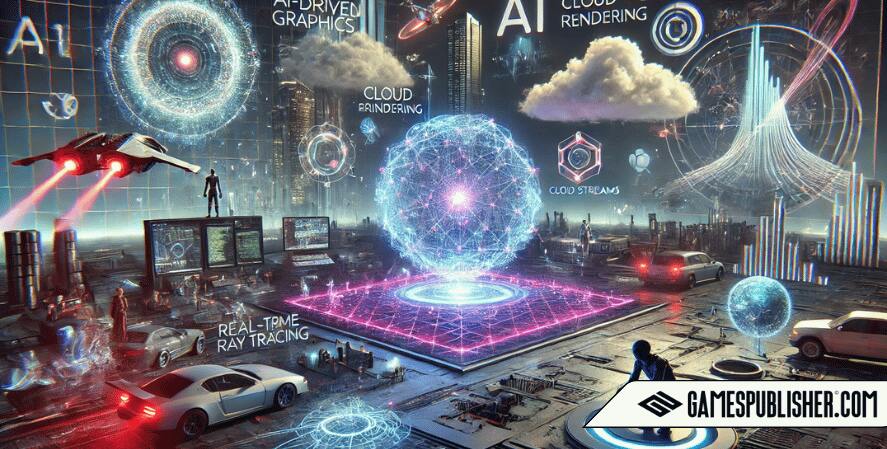Welcome to Gamespublisher.com—your go-to spot for insights into game development and publishing. In today’s gaming world, stunning graphics aren’t just a bonus; they’re essential.
They pull players into immersive worlds, making every game more exciting. This article dives deep into two game-changing technologies: ray tracing and photogrammetry. Let’s explore how they’re reshaping the gaming industry.
Understanding Ray Tracing in Modern Games

What is Ray Tracing?
Imagine light in the real world. It bounces off objects, creating shadows and reflections. Ray tracing mimics this behavior in games. Instead of guessing how light should look, ray tracing calculates it. This leads to more lifelike visuals.
But what exactly does this mean for gamers? With ray tracing, water reflects the environment accurately. Shadows look softer and more natural. It’s like stepping into a movie!
Technical Requirements and Challenges
To run games with ray tracing, you need powerful hardware. Graphics cards like NVIDIA’s RTX series are built for this. They handle the heavy lifting, ensuring smooth gameplay.
However, ray tracing demands a lot of computing power. This can impact game performance. Some gamers might notice lower frame rates. Game developers work hard to balance stunning visuals with smooth gameplay.
Current Uses in Popular Games
Many top games now use ray tracing. Titles like Cyberpunk 2077, Minecraft RTX, and Control showcase its power. In Cyberpunk 2077, the city’s neon lights reflect beautifully on wet streets. Minecraft RTX transforms the blocky world into a visual masterpiece with realistic lighting.
Future Prospects
The future looks bright for ray tracing. As technology improves, even mid-range PCs might handle it with ease. Companies are also exploring AI-driven solutions to optimize performance. This means better graphics without sacrificing gameplay.
Photogrammetry: Bringing Realism to Game Worlds

What is Photogrammetry?
Ever wondered how some games have ultra-realistic textures? Enter photogrammetry. This technique involves taking many photos of real-world objects or environments. These photos are then processed to create detailed 3D models.
Think of it as capturing the real world and placing it into a game. Rocks, trees, buildings—all can be recreated with stunning accuracy.
Benefits of Photogrammetry in Game Development
Photogrammetry offers several perks:
- Realism: Assets look true to life.
- Efficiency: Saves time compared to creating models from scratch.
- Cost-Effective: Reduces the need for large art teams.
For game developers, this means they can craft immersive worlds faster and at a lower cost.
Implementation Process
Here’s how photogrammetry works:
- Capture: Take numerous photos of the object from different angles.
- Processing: Use software to stitch these photos into a 3D model.
- Refinement: Clean up the model, ensuring it’s game-ready.
- Integration: Import the model into a game engine like Unreal or Unity.
Case Studies and Examples
Games like Battlefield 1 and Star Wars Battlefront have used photogrammetry. In Battlefield 1, environments feel authentic, transporting players to World War I settings. The detailed textures enhance immersion, making every battle feel real.
The Rise of Real-Time Rendering Technologies
What is Real-Time Rendering?
Real-time rendering means creating images on the fly. When you move in a game, the visuals update instantly. This is crucial for interactive experiences like gaming.
Without real-time rendering, games would be static and unresponsive. It’s the backbone of the dynamic worlds gamers love.
Advancements and Tools
Modern game engines like Unreal Engine and Unity have pushed real-time rendering forward. They’ve integrated tools for ray tracing and photogrammetry, making it easier for game developers.
These engines offer:
- User-Friendly Interfaces: Even beginners can craft impressive scenes.
- Optimization Tools: Ensure games run smoothly across devices.
- Asset Stores: Access to pre-made models and textures.
Impact on Game Design and Development
With advanced rendering tools, game developers can focus more on creativity. They can design complex scenes without worrying about performance. This leads to richer stories and more engaging gameplay.
Hybrid Approaches: Combining Techniques for Maximum Impact

Why Combine Ray Tracing and Photogrammetry?
Using both ray tracing and photogrammetry elevates game graphics to new heights. While photogrammetry provides realistic textures, ray tracing adds lifelike lighting. Together, they create immersive worlds that captivate players.
Case Studies
Metro Exodus is a prime example. The game combines photogrammetry for detailed environments and ray tracing for dynamic lighting. The result? A post-apocalyptic world that feels eerily real.
Another example is The Vanishing of Ethan Carter. It uses photogrammetry to craft its landscapes, making exploration a visual treat.
Challenges and Considerations
While combining these techniques offers stunning visuals, there are challenges:
- Performance: Both methods are resource-intensive.
- Development Time: Requires meticulous work.
- Specialized Knowledge: Teams need expertise in both areas.
Game publishers and developers must weigh these factors during production.
The Future of Game Graphics: Trends and Predictions

Emerging Technologies and Innovations
The video game industry is ever-evolving. Here are some trends on the horizon:
- AI-Driven Graphics: Using AI to enhance textures and animations.
- Cloud-Based Rendering: Offloading heavy computations to the cloud.
- Advancements in AR/VR: Creating more immersive experiences.
Industry Expert Insights
Experts predict a shift towards more accessible high-end graphics. As hardware becomes more affordable, even casual gamers can enjoy top-tier visuals. Additionally, real-time ray tracing might become the standard, making games more lifelike than ever.
Practical Considerations for Developers
For game developers, staying updated is key. Here are some tips:
- Continuous Learning: Attend workshops and courses.
- Experimentation: Try out new tools and techniques.
- Community Engagement: Join forums and groups to share knowledge.
By embracing innovation, developers can craft games that stand out in the crowded gaming industry.
Conclusion
We’ve journeyed through the transformative world of ray tracing and photogrammetry. These technologies are setting new standards in game graphics, offering players unparalleled visual experiences.
At Gamespublisher.com, we champion innovation. We encourage game developers and game publishers to explore these tools, pushing the boundaries of what’s possible.
The future of gaming is bright, with ever-evolving graphics leading the charge. Stay tuned with us for more insights into the gamer world and the technologies shaping it.
Loading survey...

